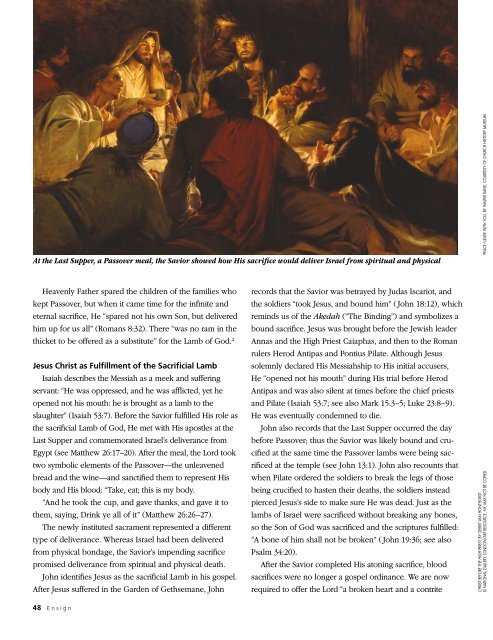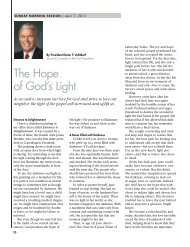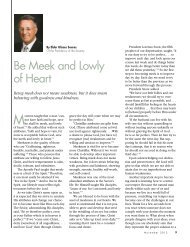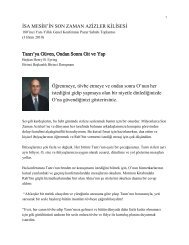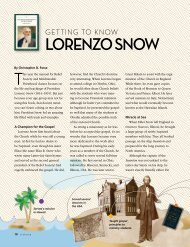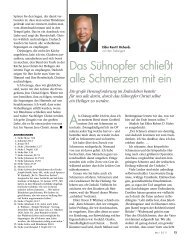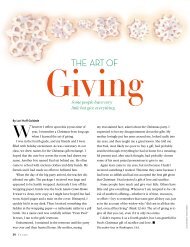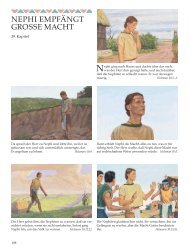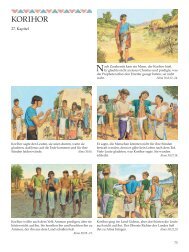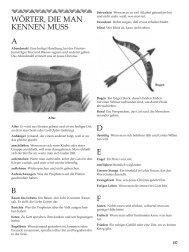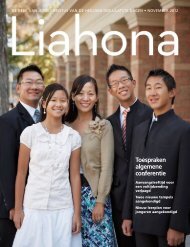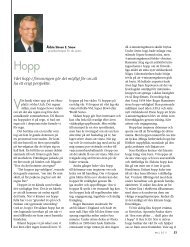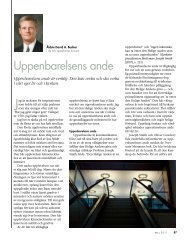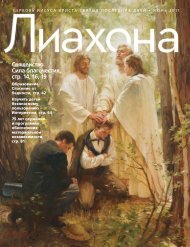April 2013 Ensign - The Church of Jesus Christ of Latter-day Saints
April 2013 Ensign - The Church of Jesus Christ of Latter-day Saints
April 2013 Ensign - The Church of Jesus Christ of Latter-day Saints
You also want an ePaper? Increase the reach of your titles
YUMPU automatically turns print PDFs into web optimized ePapers that Google loves.
At the Last Supper, a Passover meal, the Savior showed how His sacrifice would deliver Israel from spiritual and physical<br />
Heavenly Father spared the children <strong>of</strong> the families who<br />
kept Passover, but when it came time for the infinite and<br />
eternal sacrifice, He “spared not his own Son, but delivered<br />
him up for us all” (Romans 8:32). <strong>The</strong>re “was no ram in the<br />
thicket to be <strong>of</strong>fered as a substitute” for the Lamb <strong>of</strong> God. 2<br />
<strong>Jesus</strong> <strong>Christ</strong> as Fulfillment <strong>of</strong> the Sacrificial Lamb<br />
Isaiah describes the Messiah as a meek and suffering<br />
servant: “He was oppressed, and he was afflicted, yet he<br />
opened not his mouth: he is brought as a lamb to the<br />
slaughter” (Isaiah 53:7). Before the Savior fulfilled His role as<br />
the sacrificial Lamb <strong>of</strong> God, He met with His apostles at the<br />
Last Supper and commemorated Israel’s deliverance from<br />
Egypt (see Matthew 26:17–20). After the meal, the Lord took<br />
two symbolic elements <strong>of</strong> the Passover—the unleavened<br />
bread and the wine—and sanctified them to represent His<br />
body and His blood: “Take, eat; this is my body.<br />
“And he took the cup, and gave thanks, and gave it to<br />
them, saying, Drink ye all <strong>of</strong> it” (Matthew 26:26–27).<br />
<strong>The</strong> newly instituted sacrament represented a different<br />
type <strong>of</strong> deliverance. Whereas Israel had been delivered<br />
from physical bondage, the Savior’s impending sacrifice<br />
promised deliverance from spiritual and physical death.<br />
John identifies <strong>Jesus</strong> as the sacrificial Lamb in his gospel.<br />
After <strong>Jesus</strong> suffered in the Garden <strong>of</strong> Gethsemane, John<br />
48 <strong>Ensign</strong><br />
records that the Savior was betrayed by Judas Iscariot, and<br />
the soldiers “took <strong>Jesus</strong>, and bound him” ( John 18:12), which<br />
reminds us <strong>of</strong> the Akedah (“<strong>The</strong> Binding”) and symbolizes a<br />
bound sacrifice. <strong>Jesus</strong> was brought before the Jewish leader<br />
Annas and the High Priest Caiaphas, and then to the Roman<br />
rulers Herod Antipas and Pontius Pilate. Although <strong>Jesus</strong><br />
solemnly declared His Messiahship to His initial accusers,<br />
He “opened not his mouth” during His trial before Herod<br />
Antipas and was also silent at times before the chief priests<br />
and Pilate (Isaiah 53:7; see also Mark 15:3–5; Luke 23:8–9).<br />
He was eventually condemned to die.<br />
John also records that the Last Supper occurred the <strong>day</strong><br />
before Passover; thus the Savior was likely bound and crucified<br />
at the same time the Passover lambs were being sacrificed<br />
at the temple (see John 13:1). John also recounts that<br />
when Pilate ordered the soldiers to break the legs <strong>of</strong> those<br />
being crucified to hasten their deaths, the soldiers instead<br />
pierced <strong>Jesus</strong>’s side to make sure He was dead. Just as the<br />
lambs <strong>of</strong> Israel were sacrificed without breaking any bones,<br />
so the Son <strong>of</strong> God was sacrificed and the scriptures fulfilled:<br />
“A bone <strong>of</strong> him shall not be broken” ( John 19:36; see also<br />
Psalm 34:20).<br />
After the Savior completed His atoning sacrifice, blood<br />
sacrifices were no longer a gospel ordinance. We are now<br />
required to <strong>of</strong>fer the Lord “a broken heart and a contrite<br />
PEACE I LEAVE WITH YOU, BY WALTER RANE, COURTESY OF CHURCH HISTORY MUSEUM<br />
CHRIST BEFORE THE HIGH PRIEST, BY GERRIT VAN HONTHORST<br />
© NATIONAL GALLERY, LONDON/ART RESOURCE, NY, MAY NOT BE COPIED


